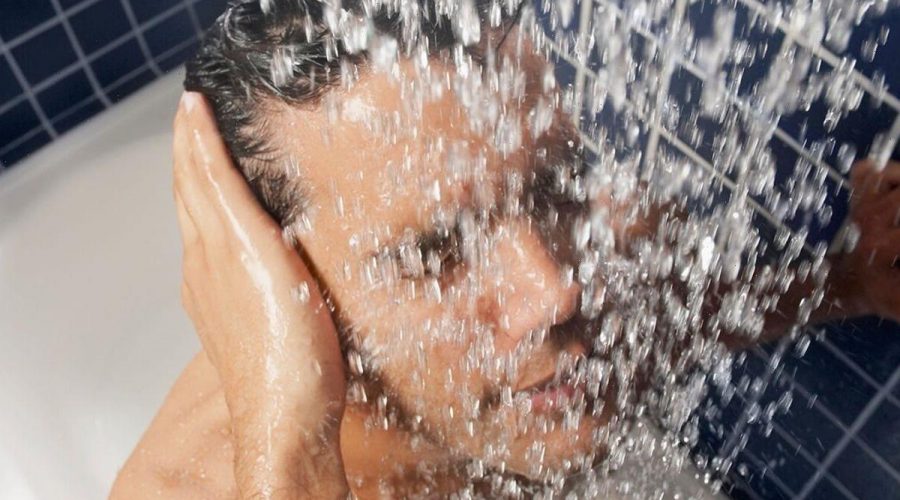3 in 5 Britons are showering in a way that can prove harmful – doctor
Showering: Dermatologist recommends ways to keep skin healthy
We use your sign-up to provide content in ways you’ve consented to and to improve our understanding of you. This may include adverts from us and 3rd parties based on our understanding. You can unsubscribe at any time. More info
Showering brings both mental and physical health benefits, but it matters how you do it. In fact, you can undo a lot of the good work by bathing in water that’s too hot. A new study has found that three in five Britons are bathing above the recommended temperature suggested by experts, which is between 36-40°C.
The finding has raised alarm bells because high bathing temperatures can cause a cascade of health problems, from damage to the skin to an increase in blood pressure and nausea.
The study, ran by bathroom retailer Sanctuary Bathrooms, delved further into the nation’s bathing habits and asked participants to record the temperature of their bath over the course of two weeks.
Results showed that three in five participants were bathing above the recommended 40°C maximum temperature suggested by experts, at an average of 42°C.
The findings are particularly salient now the UK is heading into the colder months, where the temptation to indulge in a hot shower is at its greatest.

Given the timing, and the shocking results of the study, Sanctuary Bathrooms worked with health experts to reveal the ideal temperature, and the impacts of regularly bathing above it.
Abbas Kanani, Pharmacist at Chemist Click explained: “The optimum bath temperature should be around 36-40°C, or just above the average body temperature of 37°C – Brits should avoid going above 40°C.”
Doctor Deborah Lee of Dr Fox Pharmacy also sounded the alarm: “Anywhere above 40°C is too hot. Although temperatures above 40°C are unlikely to burn the skin, this can still have health consequences.”
Besides the uncomfortable sensation of lowering yourself into the bath when it’s too hot, there are impacts on your skin that may make you reconsider the temperature of your tub.
DON’T MISS
Avoid four drinks to lower risk of blood clots [ADVICE]
Acholic stools ‘common’ sign of pancreatic cancer [INSIGHT]
Eating a certain nut could lower cholesterol levels [TIPS
Doctor Lee also says that bathing in hot water can result in damaged skin, an increase in blood pressure, and nausea.
She continued: “Bathing and showering in very hot water strips the natural oils from the skin, leaving it dry, red, and brittle. Sometimes the skin overreacts to hot water and produces too much oil to try and compensate for the dryness.
“So, if you have oily skin, taking long, hot baths and showers can make this worse.
“The heat opens the pores and causes the skin to sweat, which can also cause acne to flare up. It can also cause the skin to age more quickly, resulting in the development of fine lines.”

If like many Britons, your bath water is a little on the hot side, the experts also explain the measures you can take to keep your skin protected and hydrated, both before and after bathing, as well as what to do if you feel dizzy or nauseous following a hot bath.
Top tips on taking care of your skin and health include testing the temperature of your bathtub when filling it using a thermometer. Or, if it feels hot, leave for a few minutes to cool down slightly in case it is above the recommended temperature
The experts also recommend you:
- Try to keep bathing time between 10-20 minutes so you can enjoy the calming benefits of bathing, without drying your skin out
- Use moisturising body wash or bubble bath to maximise hydration to the skin
- After exiting the bath, use a nourishing body moisturiser on damp skin to prevent any dryness
- Drink a glass of water after a hot bath, to keep your skin hydrated and make up for any fluids you may have lost.

What to do if you feel dizzy or nauseous
Ever climbed out of the bath and felt dizzy? It turns out that a sudden drop in blood pressure is another impact of bathing too hot.
Abbas Kanani advised: “Take a seat, preferably outside the bathroom where the temperature is not likely to be as hot and allow your blood pressure to restore (usually around five minutes in healthy individuals).
“Take long and deep breaths and allow your body to cool down. Drink cold water slowly, try not to make any sudden movements, and eat a light meal – these can all help raise blood pressure and alleviate feelings of sickness.”
James Roberts, Director at Sanctuary Bathrooms, added: “It is an idyllic image of bathroom relaxation: a hot, steamy bath filled with lots of bubbles, and a place to soak and relax away. But many Britons may not realise they could be putting the body under unnecessary stress or discomfort by bathing at high temperatures.
“This research shows that over half of us may be guilty of having a bath too hot from time to time. As such, it is important to take a little time to ensure our water is cooler before enjoy a good soak as the experts suggest, in order to enjoy bathing and maintain our wellbeing.
You can learn more about the health impacts of bathing too hot, as well as the damage it can do to your bathroom and how to fix it, in Sanctuary Bathrooms’ blog here.
Source: Read Full Article
